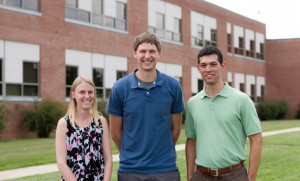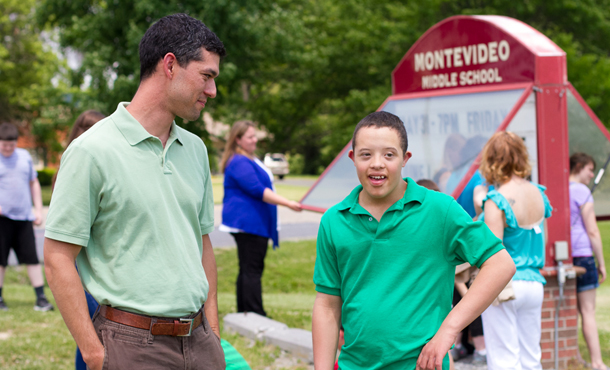From the moment the eighth-graders left Montevideo Middle School for their annual field trip to Baltimore until they returned hours later, Nathan Medlin was every bit a part of the crowd. His classmates greeted him enthusiastically in the morning, included him in their clusters around the tanks at the National Aquarium, and made sure he had as much fun as they did at the Orioles’ game in Camden Yards.
The fact that Nathan, who has an intellectual disability, hardly talked back didn’t deter his classmates. Instead, they focused on the many abilities they all share: to smile, to get excited about jellyfish, to devour ballpark hamburgers. For Jesse Rodriguez ’05, a special education teacher who accompanied Nathan on the field trip, it was a moving testament to an attitude of inclusion and acceptance prevalent in the school.
“Our eighth-grade class is a class that has class,” wrote Rodriguez in a blog post on the Rockingham County Public Schools website. “Many students that day went out of their way to help Nathan, to make him feel comfortable, welcome and part of the group.” He continued:

Stories like this don’t end up in the paper. They don’t show up in test scores and they aren’t reflected on report cards. But I believe that stories like this tell far more about the types of adults these kids are going to become than any number or grade ever will come close to predicting. I also believe that the future for people with disabilities is becoming brighter and brighter because of the interactions that are happening now with their non-disabled peers.
Attitudes of inclusion, acceptance, at middle school
Nathan’s experience on the field trip exemplifies a remarkable change that has occurred at Montevideo Middle School since Rodriguez and his colleague, Kendal Swartzentruber ’07, MA ’12 in education, helped establish a “peer student” program there. The program brings general education students into certain special education classrooms, where they help classmates with intellectual disabilities work toward individual educational goals. The program also creates friendships between groups of students traditionally segregated from one another and develops peer students into advocates for people with disabilities.
According to Rodriguez, peer students overwhelmingly say the experience taught them to be more patient and accepting, and to focus on others’ numerous abilities rather than specific disabilities. As one wrote in a journal entry: “Working with the special needs students has shown me no matter what the disability may be, they are very caring and smart. It has shown me to keep an open heart to anyone who is ‘different.’”
Since the program began, teachers say the student body has become noticeably more welcoming and accepting; students with disabilities now sit in the cafeteria with their peer student friends and are far more integrated into peer students’ wider social circles. Using the “R-word” and other derogatory terms has become taboo and will now earn the offending student a rebuke from his or her classmates.
Empathetic rather than apathetic
“The culture of our school is changing in a way where we’re getting kids to care about each other and to be empathetic rather than apathetic,” said Drew Miller, principal of Montevideo Middle School.
Long before they became teaching colleagues, Rodriguez and Swartzentruber were once students themselves at Montevideo Middle School; they have been best friends ever since. They later developed an interest in special education as peer students in a similar program at Spotswood High School that eventually became their model for the middle school program they helped launch. As undergraduates at EMU, both were recognized as “Teachers of Promise.”
Swartzentruber said the EMU education program’s emphasis on caring relationships was a major influence on the design of the peer student program. When he began teaching at the school, he observed that plenty of time was spent developing student-teacher relationships. At the same time, he saw little being done to build relationships between special education students and the rest of the student body. Changing that became a major goal of the peer student program.
Ethic of care, relationship-building, at heart of EMU
Lori Leaman, a special education professor at EMU who taught Rodriguez and Swartzentruber, noted that an ethic of care and relationship-building lies at the heart of the education program’s curriculum. “We have this belief that every individual that God created has potential and is a gift to everyone around them. We’ve always encouraged our teachers to be looking for that,” she said.
Calling Rodriguez and Swartzentruber “deeply committed to the potential of others, and deeply gifted in what they do,” Leaman said she wasn’t surprised to learn that the program they helped start has had such a dramatic effect on the school as a whole.
After starting with just eight handpicked students four years ago, the peer student program has become the most popular elective for seventh- and eighth-graders at the middle school. For the 2012-13 academic year, about 150 students signed up for the class – about one-third of all eligible students at the school, and three times as many as the program could accommodate.
Deb Medlin, Nathan’s mother, said both her son and his classmates have benefited from their interactions in the peer student program.
“Prejudices form when we separate people,” she said. “The mixing between different people can only help us all.”
Peer students benefit from program too
While the peer students are responsible for helping their classmates with intellectual disabilities meet their individual educational goals, the program places just as much emphasis on the personal development of the peer students themselves, Swartzentruber said. In some cases, becoming a peer student has been extremely beneficial to kids otherwise struggling academically or socially, by providing opportunity for leadership, friendship and a sense of accomplishment from helping their classmates.
“You don’t have to be good at math or English to be nice to people,” said Kim Sass, another special education teacher at Montevideo Middle School.
Last year, Swartzentruber became an instructional coach for the county school system, putting him in the position to nurture the replication of Montevideo’s peer education model in other schools.
“This is the way to do special education, especially with a group that may be too low academically to engage in a mainstream class,” Rodriguez said.
Like Rodriguez, Swartzentruber also draws inspiration from stories like the one about Nathan’s trip to Baltimore, which transcend the narrow and frustrating focus on test scores and other numbers increasingly used to gauge the quality of an education.
“Seeing this story highlighted really gives me hope that maybe we’re starting to recapture the essence of how we learn and how we build each other up,” he said.
